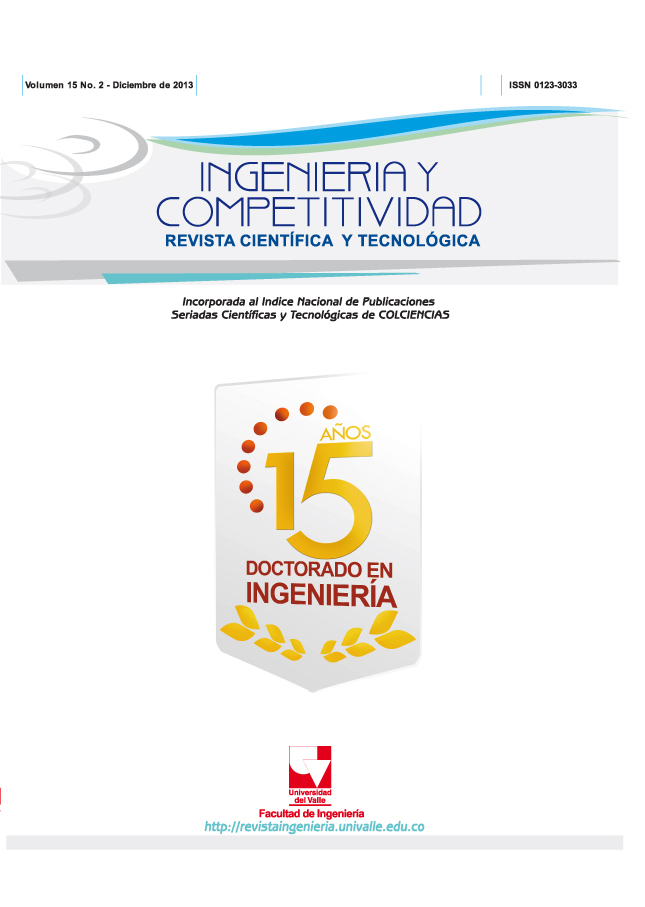Enhancement of the potential biodegradability and the mineralization of a pesticides mixture after being treated by a coupled process of TiO2-based solar photocatalysis with constructed wetlands
Main Article Content
Solar heterogeneous photocatalysis is an advanced oxidation technology, which allows a successful treatment of many recalcitrant and emergent pollutants, such as: pesticides, industrial dyes and pharmaceutical compounds. Nonetheless, despite its effectiveness, the costs of applying this process are high when it is necessary to achieve a complete mineralization or to obtain an environment-friendly effluent. Photocatalytic–biological coupled systems have become in a feasible alternative able to treat efficiently these pollutants. In this work, a coupled system consistent of two compound parabolic collectors (CPC) solar photoreactors and a subsurface flow constructed wetland (SFCW) at pilot-scale was tested for degrading a mixture of commercial pesticides used in sugar cane crops. For measuring the process performance, regarding to the pollutant removal, the increase of the BOD5/COD ratio and the total organic carbon (TOC) removal were estimated for each separated system and the coupled system. Three different levels of solar UV accumulated energy and feed flow-rates to the SFCW were considered for the experimental design. The pilot-scale coupled system increased the BOD5/COD ratio from 0.15 to 0.90, and the TOC removal (total mineralization) was around 80%.
- Fiderman Machuca-Martínez, Miguel Angel-Mueses, José Antonio Lara-Ramos, Solution of the Rachford – Rice equation by differential homotopy , Ingeniería y Competitividad: Vol. 22 No. 2 (2020): Engineering and Competitiveness
- Dorance Becerra Moreno, Yrany M. Rubio-Gomez, Andrés F. Barajas-Solano, Luisa F. Ramírez Ríos, Fiderman Machuca-Martínez, A review on the treatment of landfill leachate by coupling advanced oxidation and biological processes , Ingeniería y Competitividad: Vol. 25 No. Suplemento (2023): Edición Especial
- Charles Cardona, Fiderman Machuca-Martínez, Nilson Marriaga-Cabrales, Treatment of vinasse by using electro-dissolution and chemical flocculation , Ingeniería y Competitividad: Vol. 15 No. 2 (2013): Ingeniería y Competitividad
- Fiderman Machuca-Martinez, Patents form universities in Colombia: a new paradigm , Ingeniería y Competitividad: Vol. 21 No. 2 (2019): Engineering and competitiveness
- Fiderman Machuca-Martínez, Importance of scientific data and its publication as data paper , Ingeniería y Competitividad: Vol. 22 No. 1 (2020): Engineering and Competitiveness
- Astrid C. Angel-Ospina, Fiderman Machuca-Martínez, Catalytic ozonation in treatment of Contaminants of Emerging Concern in wastewater: A bibliometric analysis , Ingeniería y Competitividad: Vol. 24 No. 1 (2022): Ingenieria y Competitividad
- Miguel A. Mueses, Fiderman Machuca-Martínez, Molecular adsorption model for organic compounds over TiO2 – P25 by protonic distribution affinity , Ingeniería y Competitividad: Vol. 15 No. 2 (2013): Ingeniería y Competitividad
- María Margarita Guerra, Rodinson Arrieta- Perez, Jose Colina-Marquez, Modeling of a Solar Heterogeneous Photocatalytic Reactor with TiO2 for Treatment of Wastewater Contaminated By Albendazole , Ingeniería y Competitividad: Vol. 21 No. 2 (2019): Engineering and competitiveness
- Ruben Jesus Camargo Amado, Juan Carlos Osorio, Fiderman Machuca-Martinez, Doctorado en Ingeniería de la Universidad del Valle: un pilar fundamental para el Desarrollo Regional y Nacional , Ingeniería y Competitividad: Vol. 25 No. Suplemento (2023): Edición Especial
- Janet Bibiana García Martínez, Fiderman Machuca-Martinez, Ingri Y. Cardenas-Gutierrez, Protocol for the maintenance of strains and escalation in the production of microalgae of industrial interest , Ingeniería y Competitividad: Vol. 23 No. 1 (2021): Engineering and Competitiveness
Authors grant the journal and Universidad del Valle the economic rights over accepted manuscripts, but may make any reuse they deem appropriate for professional, educational, academic or scientific reasons, in accordance with the terms of the license granted by the journal to all its articles.
Articles will be published under the Creative Commons 4.0 BY-NC-SA licence (Attribution-NonCommercial-ShareAlike).





